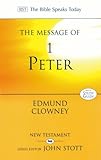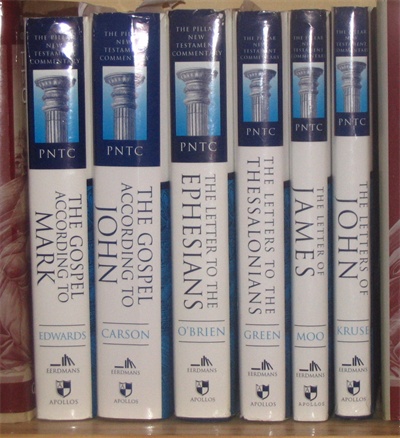
 Although this book covers only four short New Testament chapters, it is larger than many of the others in the Bible Speaks Today series. This is surprising as the BST series does not contain academic or detailed exegetical material, but rather focuses on practical application. 250 pages means that whole chapters can be devoted to just one or two verses. While this makes for a very thorough exposition of these books, I wonder whether it is a bit long for the BST target audience.
Although this book covers only four short New Testament chapters, it is larger than many of the others in the Bible Speaks Today series. This is surprising as the BST series does not contain academic or detailed exegetical material, but rather focuses on practical application. 250 pages means that whole chapters can be devoted to just one or two verses. While this makes for a very thorough exposition of these books, I wonder whether it is a bit long for the BST target audience.
Lucas has written the introductions, while Green wrote the commentary and appendix on authorship, but their styles are similar and there is no sense of discontinuity. Lucas’ introduction to 2 Peter is itself a mini-commentaries on the book, tracing through its main messages and themes, and barely touching on authorship and dating. Those who have read Lucas’ BST volume on Colossians will immediately notice similarities, for both books are understood to be attacks on false teaching, by those claiming to have “knowledge”.
False teaching in the church is something that Lucas and Green clearly feel passionately about, and they don’t just have their sights set on liberal or cult doctrines. They believe that muddled and even dangerous teaching abounds from those who claim to be evangelical. It is difficult to disagree with this assessment, but it is also difficult as a charismatic not to see oneself portrayed as the villain. Strong hints at cessationism, criticism of modern “apostolic” ministries, and warnings against seeking “experience” are all tell-tale signs of an antipathy towards charismatic doctrine.
Green, like Lucas, clearly believes in line by line expository preaching, and this is how the book is structured. Each chapter is like a mini-sermon on the few verses in question, starting with some brief introductory comments, followed by the NIV text, and then dealing with the message of those verses under clearly defined headings.
2 Peter is described as a homily on Christian growth, but with the focus very much being on the maturity needed to combat the false teaching. As with Colossians, the essence of the heresy is seen to be “Christ plus” – requiring people to move beyond Christ to something better (again some thinly veiled polemic against the Pentecostal doctrine of the baptism in the Holy Spirit may be detected). The false teacher’s denial of the second coming is seen as their excuse for relaxing moral standards, and it is here that some contemporary liberal trends within evangelicalism come under fire.
When a passage has many possible interpretations, the options are listed and normally general lesson drawn that does not rely too heavily on one interpretation. Although the style of commentary is expository, it does not often delve into matters of Greek vocabulary and syntax. The main modern commentary that is interacted with is Bauckham’s (and sometimes Michael Green’s) and older commentators such as the Puritans are occasionally quoted.
The introduction to Jude lists similar themes between the books. Jude is said to emphasise the “closed” nature of the faith – it is not evolving even at this early stage. The authors are concerned to properly clarify his use of extrabiblical books, that he did not see them as on a par with Scripture.
An appendix deals in more depth with the issues that the introductions to the books would normally be expected to consider. It defends Peter as author of 2 Peter against both claims of pseudonymous authorship, and “testament” authorship (Bauckham), and deals with differences in Greek writing style between 1 and 2 Peter. Similarly Jude the half-brother of Jesus is seen as the author of the book that bears his name. There is also a study guide as with all BST New Testament volumes, although it is difficult to imagine many small groups wanting to spend 24 sessions working through these two short books.
I have criticised this book for perhaps being too long, and hostile towards charismatics, but it I still found it very helpful and thorough. The writing style is easy to follow, and the warnings against false teaching creeping in are worth seriously contemplating. It serves as a forceful reminder that error can creep in even in supposedly “pure” churches that have separated from more traditional and doctrinally compromised church groupings. And individually, we must not be too proud to think we can “wobble” doctrinally, so we must heed the message to continually grow in the faith.

This volume in the Bible Speaks Today series presents the main themes of 1 Peter as the suffering that Christians must face as “resident aliens” in a world of rebels against God. The introduction is brief, and the style of commentary is expository – almost a series of sermons. At over 230 pages, the material is covered quite slowly, allowing Clowney to take time to discuss other related passages, and use examples from church history. There are places where it approaches being an academic commentary, for example a number of pages are devoted to the problematic section in 3:18-22, establishing his interpretation very methodically, and utilising a number of quotes from apocryphal writings to bolster his case.





 The Pillar commentary series has been slowly but surely growing for well around 20 years now, with thirteen published volumes, and
The Pillar commentary series has been slowly but surely growing for well around 20 years now, with thirteen published volumes, and 

